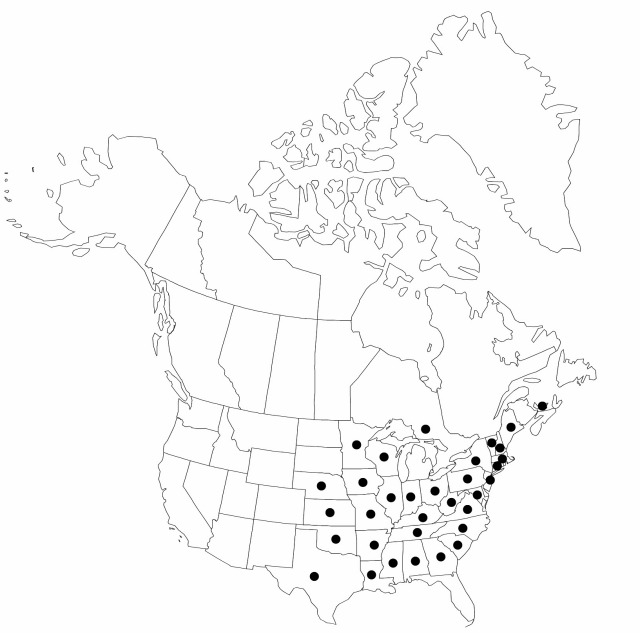Scirpus georgianus
Bull. Torrey Bot. Club 27: 331. 1900.
Plants cespitose; rhizomes short, tough, fibrous. Culms: fertile ones upright or reclining; nodes without axillary bulblets. Leaves 6–12 per culm; sheaths of proximal leaves green or brownish; proximal sheaths and blades with septa few-to-many, usually not conspicuous; blades 19–50 cm × 6–13 mm. Inflorescences terminal; rays ascending or divaricate (often both in the same inflorescence), proximal branches smooth, distal branches scabrous or scabrellous, rays often bearing axillary bulblets; bases of involucral-bracts green, margins brown or at least speckled with redbrown, not glutinous. Spikelets in clusters of 4–35 (largest cluster with 16 or more), spikelets sessile, ovoid, 2–4 × 1–2 mm; scales brown or blackish brown with pale midribs, elliptic, 1–1.8 mm, apex mucronate, mucro 0.1–0.3 mm. Flowers: perianth bristles persistent when present, 0–3, slender, straight or curved, much shorter than (rarely to 0.7 times as long as) achene, smooth or rarely with round-tipped, retrorse teeth near apex, enclosed within scales; styles 3-fid. Achenes pale-brown to almost white, elliptic or obovate in outline, plumply trigonous or planoconvex, 0.6–1.2 × 0.4–0.5 mm. 2n = 50, 52, 54.
Phenology: Fruiting late spring–early summer (Jun–Jul).
Habitat: Moist meadows, marshes, ditches
Elevation: 0–600 m
Distribution

Introduced; Ont., P.E.I., Ala., Ark., Conn., Ga., Ill., Ind., Iowa, Kans., Ky., La., Maine, Md., Mass., Minn., Miss., Mo., Nebr., N.H., N.J., N.Y., N.C., Ohio, Okla., Pa., S.C., Tenn., Tex., Vt., Va., W.Va., Wis., New Zealand
Discussion
In the northern part of its range, Scirpus georgianus occurs in disjunct localities. It is found as far north as Prince Edward Island; it seldom grows in New England. It is unknown from Michigan; it occurs in northern Wisconsin. The species is probably a recent introduction in at least some of these disjunct localities. Most old reports of S. atrovirens var. georgianus from the northeastern United States and eastern Canada are based on specimens of S. hattorianus.
The three cytotypes of Scirpus georgianus are identical morphologically; they seem to occur in slightly different habitats (A. E. Schuyler 1976).
Scirpus georgianus is distinctive in having the perianth bristles absent or rudimentary (seldom more than 0.2 times as long as achene and usually smooth). Rarely, a few achenes will be found with bristles up to 0.75 times as long as achene and with a few barbs near the tip. Such plants have been confused with S. hattorianus in the past. Scirpus georgianus differs in having fewer bristles (never more than three per achene, and usually only one well developed) and in the bristles either being smooth or having the barbs confined to the extreme tip. In addition, S. georgianus differs from S. hattorianus in having less black pigmentation in the scales (thus the heads tend to appear brownish, not blackish).
In Scirpus georgianus, as in other species of Scirpus, the filaments often persist long after the anthers have been shed, and specimens of S. georgianus are sometimes misnamed because the filaments are mistaken for perianth bristles. Only three filaments per flower occur and they are thicker than the bristles and never toothed or barbed.
Scirpus georgianus occasionally hybridizes with S. atrovirens and S. hattorianus.
Scirpus georgianus, S. flaccidifolius, S. hattorianus, S. atrovirens, and S. pallidus differ only in minute characteristics, and it may be necessary to compare specimens of them in order to make reliable identifications. Despite their close morphologic similarities, their characteristics are reasonably consistent even in areas where they coexist and occasionally hybridize.
Selected References
None.
Lower Taxa
"shortened" is not a number.
